Costa Rica has a vast array of offerings, especially if you love nature and we’re huge nature fans over here. My tale below focuses on rain forests, butterflies, birds and the volcano action but be sure to check out our Costa Rica section for more tales and recommendations.
Butterfly Farm – Alejeula
The butterfly farm on the outskirts of Alejeula of San Jose, was the first commercial butterfly farm in Latin America and opened in 1983. It provided a fascinating overview of every stage of a butterfly’s life. There was a bee garden, traditional ox cart rides and numerous tropical birds. We had an excellent local guide who joined us en route back to San Jose in a cramped minivan. The guide to the Spanish-speaking tour also joined us.
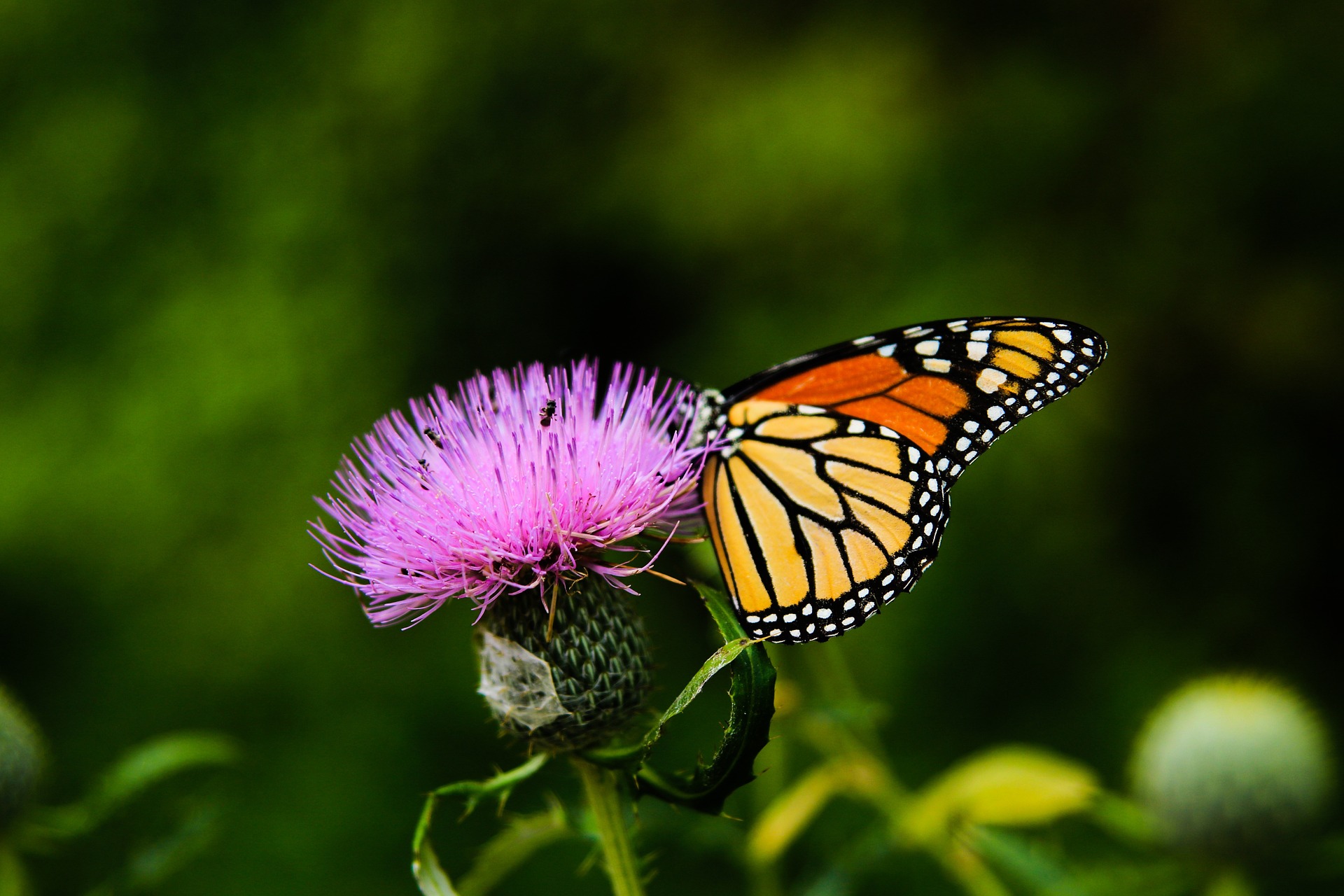
An interesting but busy conversation followed between the two guides, an American in his late 40s from Brooklyn, his 21 year old son, Jarod and I. It started with a couple ‘off the beaten path’ questions not answered on the tour, and moved into an ecological discussion about Costa Rica rainforests, local San Jose culture and lifestyle.
The Spanish guide, who was averse to anyone who used theory and academic degrees to guide their hearts and career, was a former civil servant and now happily married to a biologist with three grown children. All of them had such a healthy carefree attitude about life — another first in a series of consistencies on our trip — a prevalent national attitude that is likely a key factor to why Costa Rica has one of the longest life expectancies in the world.
The guides suggested that we explore an outdoor mall area in San Jose: Centro Commercial El Pueblo. It had gift shops and slightly overpriced restaurants serving Costa Rican style seafood. Mostly full of Europeans and Americans who arrived well after 8 pm to engage in a three-hour meal, the local guides had frequently dined at these restaurants with their families. It was hard to tell if this was largely due to the fact that their worlds have merged with Westerners or whether these wealthier, more educated Costa Ricans regularly dined at these more commercial places on a regular basis.
We ended up at the Rias Bajas, a quaint restaurant with candlelight, a couple of locals playing a xylophone like instrument in the front, reasonably priced beer and homemade bread.
Most of the prices we had encountered since our arrival were much higher than we expected for the area; closer to what we would have expected from the more commercialized island of Belize. The growing tourism trade and American owned resorts cropping up around the country has slowly been stripping away the culture of the country and raising prices, creating that division as seen in so many third world hot spots. It will be increasingly more difficult to find good bargains for food, lodging and excursions if this divide between the gringo and local tico continues.
Monteverde Area and Rainforest
Despite our hassle free experience in San Jose, we were thrilled to be heading north. We decided to go to Monteverde first and then on to the Fortuna, which is usually the reverse of how most travelers visit these two towns. People tend to travel to both areas at the same time since they are close in distance and surrounded by some of the best national wildlife parks and hiking trails in the country. Considering that we had already decided to take the plunge and travel in the middle of rainy season, it only made sense to start our journey in the middle of a rainforest, so we could use our raincoats, capes, umbrellas, waterproof torch and plastic bags.
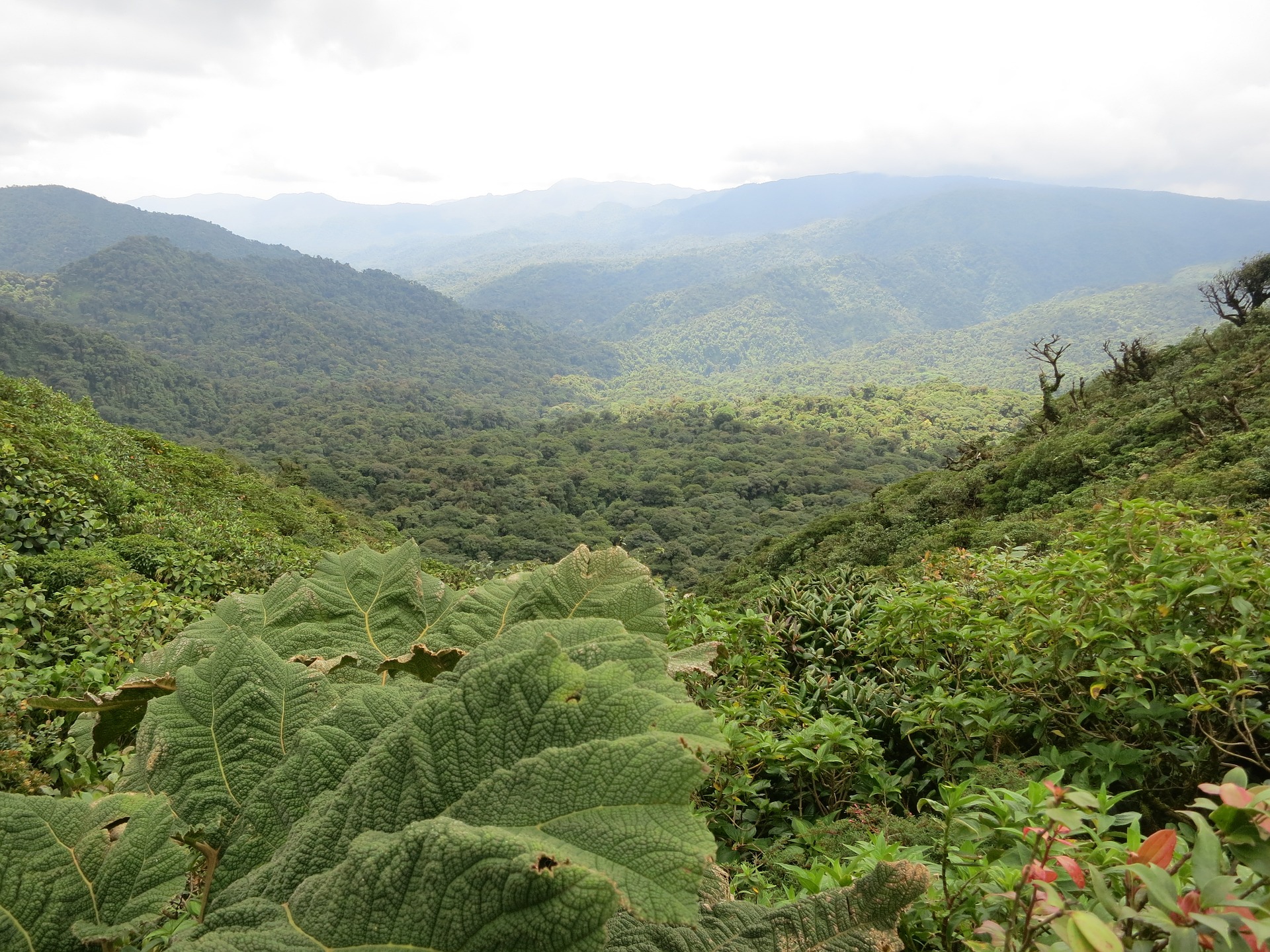
Most of the buses to major destinations depart from the Coca-Cola terminal in San Jose, so-called after a Coca-Cola bottling plant which used to exist on the site many years ago.
I first thought that the naming of a Costa Rica bus terminal after an American conglomerate was more evidence of western ‘corporate’ infiltration, which was partly true. I had no idea; however, just how prevalent Coca-Cola was, nor how many times we would see a Coca-Cola sign over the next few weeks.
There was no bus terminal to Monteverde a couple of years ago, which reflects how isolated this community remains despite the enormous increase in popularity from Westerners wanting to explore Costa Rica central rainforests. Two to three buses now depart to a few destinations in this area, including Monteverde and Fortuna, from a small bus terminal called Atlantico Norte.
Unlike a lot of third world city travel, our departure could not have been smoother. A taxi dropped us off at the station by 6 am, where I discovered a local nearby kiosk and ordered an unbelievably delicious Costa Rican coffee with hot milk for 30 cents U.S.
The road to Monteverde started out well paved, bypassing Alejeula near the airport and Heredia to the north. We decided against the eastern coastal route due to the difficulty of getting north by vehicle this time of year. We had two main choices: heading north to Torteguero in a privately hired land rover to watch sea turtles lay their eggs at night, or south to Puerto Viejo and adjacent beaches near the Panama border, which apparently had an intriguing mix of Bribri Indian and black Caribbean culture. During rainy season, the Caribbean is apparently damper, wetter, and offers limited transportation since many of the roads are washed out, even with a 4WD.
Supposedly a four-hour trip to Monteverde and Santa Elena (neighboring village), it took our cramped, overcrowded bus five and a half-hours before we were dumped on the side of a road. There was nothing to see but a sign to one of the lodges we read about in Lonely Planet. Little previous planning and lack of a detailed map of the area lead us to a curbside. A woman in an ox-like tractor passed us pushing her hotel several hundred meters up the road. Her Spanish was fast and direct; our inability to make a decision about much of anything at that point of the journey led to her departure and us continuing to sit on top of our backpacks thinking about what we wanted to do and where we wanted to go.
Not far up the bumpy road on the left was a small, very basic local bureau with a phone inside for local calls, and a handful of brochures and maps. I was amazed to even find a brochure in this area considering how remote and underdeveloped the area was at the surface, not to mention the crated roads we had to survive to get there, starting some 160 miles south.
I could smell a “commission deal” brewing as he initiated a call to El Establo, a small recommended inn run by a Quaker and her Costa Rican husband, Arnaldo. It was described as a charming old fashioned place with black & white photos and a fireplace. I also thought that we might learn more about the history and culture of the area from two very unique perspectives. They quoted $40 a night and while we agreed to have a truck sent down the mountain to pick us up, we did not commit to staying there when we left. I have been through too many commission scandals in third world destinations in the past; it doesn’t take long to sense one even if you can’t understand a word of the local language, which Jarod could and I was struggling to learn.
It turned out to be the only sunny afternoon they had seen in several weeks, so we took advantage of what clear blue sky we had left and rented two horses for a couple of hours. We rode past a few farms, cow pastures, hills and through some rainforest terrain — our first exposure to the vegetation of the area. The sounds were even more enriching, spectacular and inspiring than the view around us. Between the tropical birds, the insects, butterflies, red squirrels, horses, owls, vultures, hawks, raccoons, mantled howler monkeys, anteaters, kinkajous and white nosed coatis, every step had such a ‘primal’ feeling to it. Even when we were just sitting at a cafe or in the front of our balcony at the lodge, we could acutely hear the energizing sounds of the rainforest.
We quickly found the local nearby village restaurant – actually there were two nestled fairly closely together on one strip adjacent to a very small market that sold a few of the basics, canned goods, rice, bread, selected fruit and vegetables, and a cooler with ice cream pops, yogi-sip drinks and juices. The one Arnaldo and his American wife Ruth recommended sat on the left as you faced both of them. While the other one apparently specialized in seafood, it never appeared to be open except for limited dinner hours and it was not possible to sit outside.
Ruth, while of American descent, is a fully integrated, born and bred Costa Rican. She was raised in the Monteverde area and grew up with other Costa Rican families and some of the remaining Quakers who settled here over the past few decades. She grew up in the community of local schools. The Quakers apparently had originally founded this area in 1951.
They originally came from Alabama and four of them were jailed in 1949 for refusing to register for the draft in the U.S. They decided to emigrate after their release from jail and began a search for a place to settle where they could live peacefully. After searching for land in Canada, Mexico and Central America, they decided on Costa Rica; the peaceful political policies and lack of an army matched their own philosophies. It made me think of the European who referred to Costa Rica as the Switzerland of the area.
Apparently there were 44 original settlers (men, women and children from 11 families), who arrived in the area in 1951. Some flew to San Jose, while others drove down from Alabama in trucks. It is hard to imagine driving the treacherous roads at that time considering how rough the roads are today. Ruth was the daughter of one of the original Quaker founders, and spoke fluent Spanish and English with a slight American twang. She was soft spoken, friendly, warm and giving, making it a pleasure to stay there. They helped us find a local horse farm, local hikes and guides, restaurants and the stop where buses left for other destinations. Arnaldo also steered us away from the overpriced Canopy Tour, which apparently had drawn an influx of wealthy Americans and Europeans to the area for a less invigorating ‘jungle’ experience than the newer Sky Trek and Sky Walk.
The Sky Trek
The Sky Trek is for the adventurous. It starts with a local guide harnessing up to eight people in ropes and straps to allow you to hang freely from the cables. You are then asked to choose a helmet, pair of gloves and a pulley to carry through the three and a half to four hour trek through the forest.
We first had to walk over an aerial tram platform bridge, which hung between two large trees some 2-300 feet overlooking dense rainforest. You could view birds and monkeys from the bridge and watch the vegetation and unusual formations of the trees, not found in North America. The trek included nine cables; crossings are done by placing the pulley on the cable and swinging from tree to tree some 200-500 feet above the rainforest. The cables ranged from 300-2,000 feet in length.
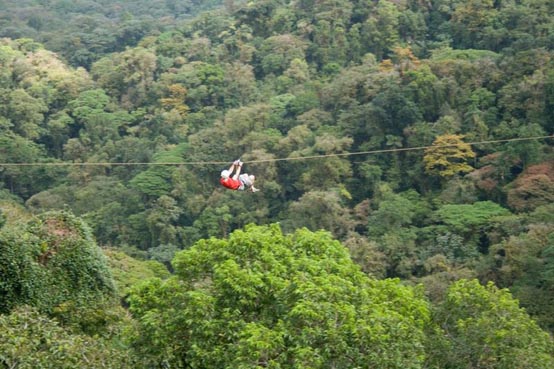 Photo credit: Arenal.net.
Photo credit: Arenal.net.
It is as exhilarating if not more so, than a sail on a small cat in rough rocky swells of the ocean, flying off a ski ramp for the very first time, hand gliding or a parachute jump. We joined an interesting group who was not only adventurous in nature, but also friendly. Father, two grown sons and mother we met on the trip, gave us a lift back to the village in their hired land rover, which allowed us to beat the afternoon rain.
We also met three Dutch guys and a German whom we developed a connection with the first day. We later hooked up with them for dinner at the local Italian restaurant, the only real tourist restaurant in the area outside of a couple in the high-end lodges for the ‘fly in, fly out,’ western tourist. We decided to try this restaurant more out of laziness; with an early morning start the next day, both of us were craving an alternative over the ‘typia’ food, which we had been regularly eating since our arrival.
As the local typia food doesn’t really change much (chicken, fish or meat (carnes) with rice and beans and sometimes egg or salad), we desperately wanted something with spices and sauce. We spent hours talking to our new friends until we were finally ousted as the place was ready to shut down. We shared travel stories and learned that we were all heading in the direction of Montezuma on the south coast; however, they were leaving on the 5 am bus the next morning and we were heading north to Fortuna the day after before heading south to the coast.
Sarah Dowell Folk Gallery & Local Art
Before we left, we discovered an interesting folk gallery at the top of a densely wooded path through trees. When you first spot the tiny sign slightly off the back of the road, it was not immediately apparent that the walk to the top will take a good twenty to thirty minutes up a steep path through a wooded forest. Once you reach the top, there is a small multi-pastel colored house that is built into a tree trump, which was barren when we arrived. Around the corner, you spot another house even further up a hill, with a front porch full of hanging plants and two very worn rocking chairs. As you enter, there is a futon on one side and a bookshelf of paperback novels on the other
 The gallery belonged to Sarah Dowell, who is fairly known in the area for her bold and distinctive work. We saw a few of her watercolors and acrylics in another gallery in the area.
The gallery belonged to Sarah Dowell, who is fairly known in the area for her bold and distinctive work. We saw a few of her watercolors and acrylics in another gallery in the area.
To my surprise, the prices were steep. When she is on the road, an Arizona native manages her gallery part time, painting and designing in his spare time below the studio. Some of his work was displayed, which was also bold and distinctive, but without a lot of color. He used a lot of natural warm earth tones; woods, stone carved squares and sandstone with somewhat of a southwestern flare to it.
We ended up talking to him for awhile after the only other two people there at the time, left – one ironically had a PriceWaterhouse/Coopers logo on the back of her shirt, which gave us both somewhat of an eerie feeling. Despite our effort to escape from corporate life into the middle of the Costa Rican rainforest, it managed to find us in one of the more remote places in the country.
During our discussion, we learned quite a bit about our Arizonan friend’s life and experience in the tropical jungle as an artist. Apparently Costa Rica is one of the best choices for a western artist trying to develop a market for their work in the third world.
Mexico is probably a close second; however he claims that it is getting much harder to do business in Mexico in addition to the complexity around its politics and poverty. He regularly flies back to the states for supplies, which are neither cheap nor light and ships them to San Jose where he picks them up. He then arranges transportation to Monteverde and taxis them to the bottom of the gallery road where he carries the supplies up the mountain to his “under the gallery,” workshop. Not an easy life.
As the sun began to set, we talked about living in this remote house in the middle of tropical rainforest. He told us of his encounters with snakes, insects, birds, spider monkeys, kinkajous and agoutis. He has also apparently spotted several quetzals, parrots and toucans while drinking a morning tea on his front porch.
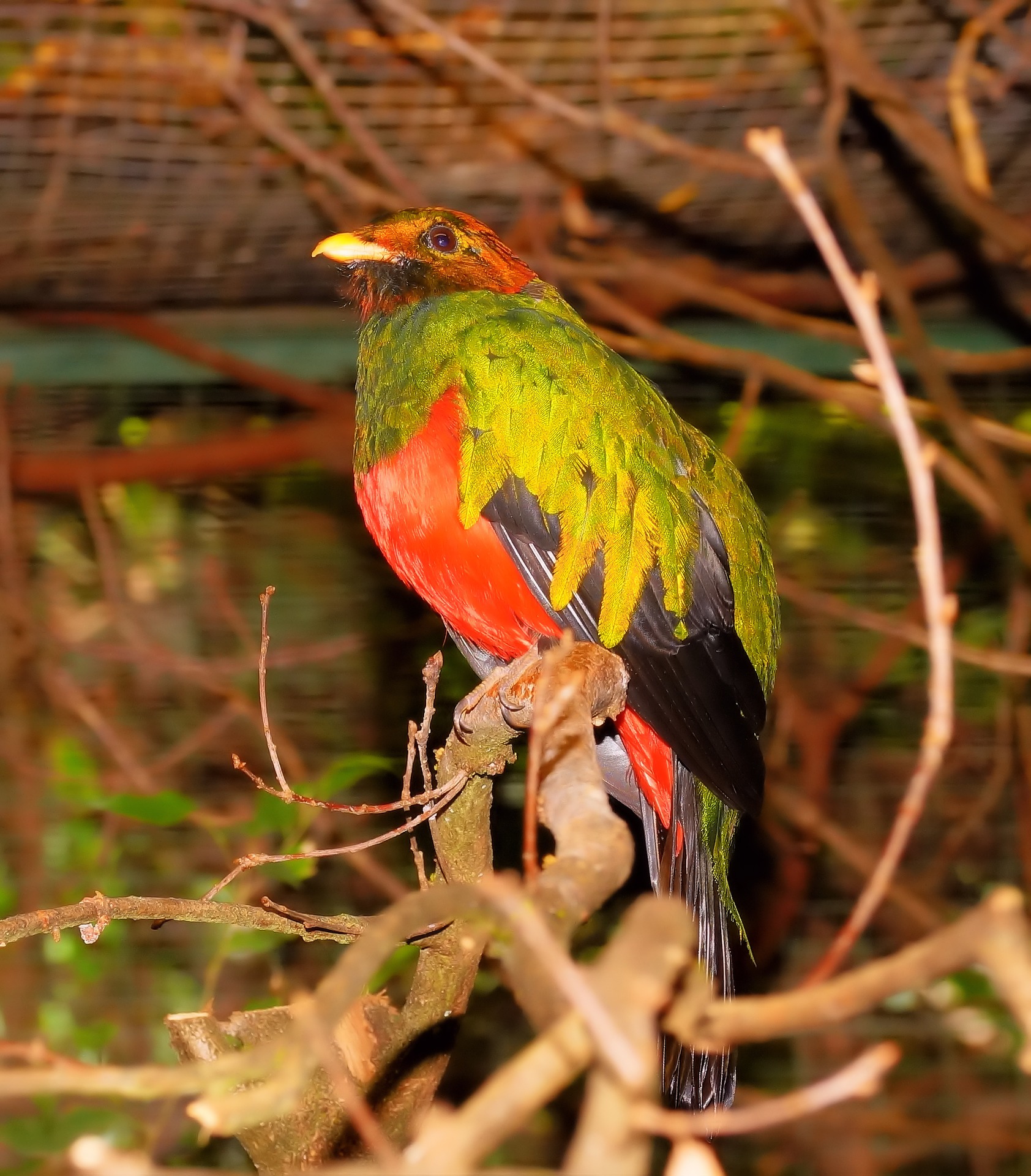
As I looked around the open beams and open nooks of the little wooden house, the stories continued as the sky started to lose daylight.
Monteverde Cloud Forest Reserve and The Quetzal
The next morning, we headed off to the Monteverde Cloud Forest Reserve on motorcycle with Elaimar, a local guide. We met up with another American couple who joined us and had already spent the previous day bird watching in the ecological reserve, another forest in the area. We started out early hoping to catch a glimpse of rare birds and other wildlife. The best time of day to spot rare and abundant birds is apparently between six and nine in the morning. Jarod was glued to his binoculars from the moment we entered the reserve.
The two Americans had been bird watching since the early 1970s. It was their mission to see the hard to find, rare quetzal, before they left Costa Rica. I joked with Jarod that they ‘had the gift of good bird spotting.’ It took us awhile to get accustomed to using the binoculars, so at first, we missed a few worthwhile bird and animal sightings.
Following several hours of hiking through the dense and vivid rainforest full of howler monkey sounds, insects, bird calls and hundreds of large blue morpho butterflies, Elaimar decided to take us to a couple of avocado trees, which quetzals apparently love to eat. There were a couple of large avocado trees in front of a school on the road back to Monteverde. We waited silently and patiently until he finally pointed to a beautifully colored resting quetzal sitting with his rear to us on a branch half way up the way up the tree.
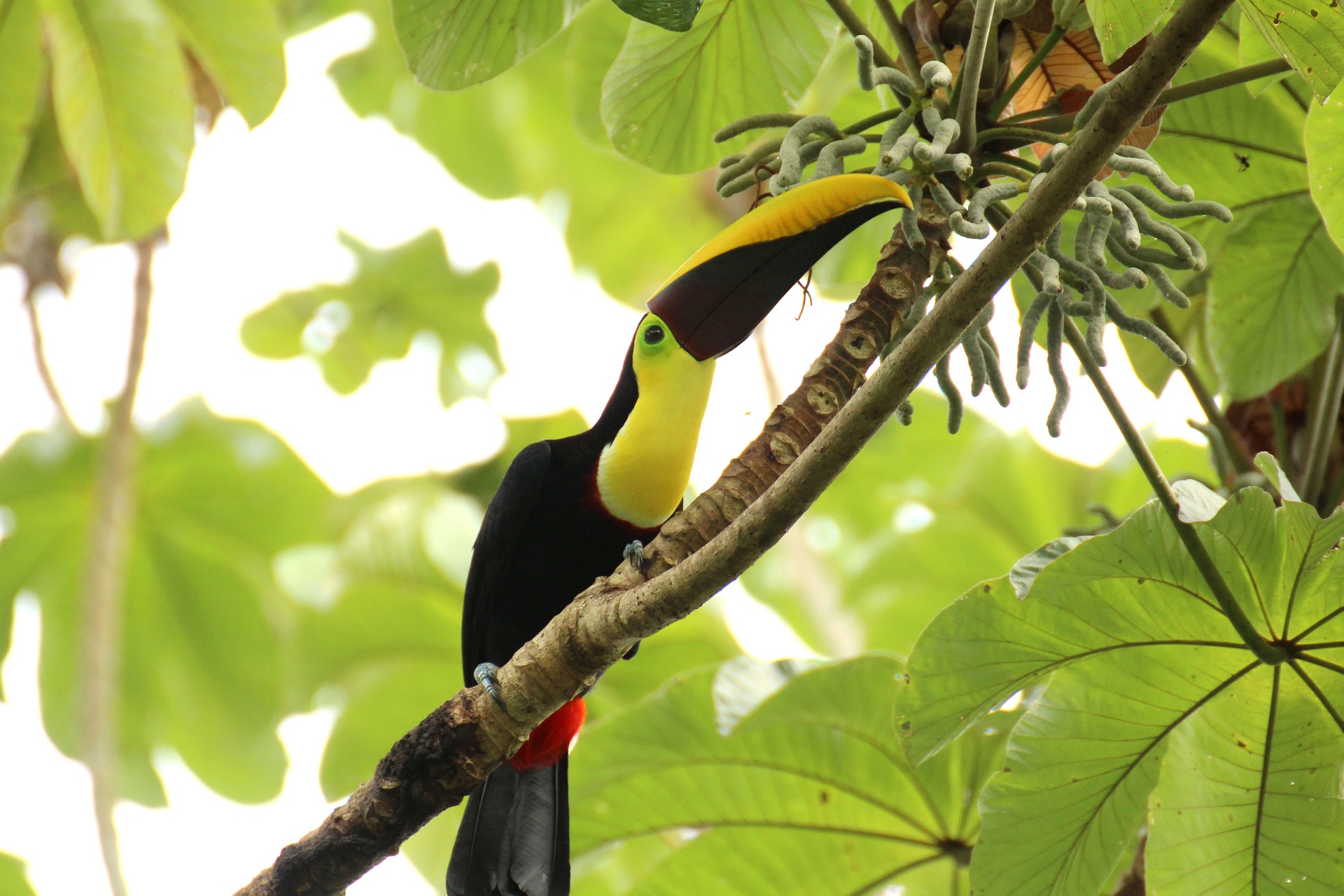 A toucan
A toucan
We carefully moved to the back of the tree to get a better side and frontal view of this amazing creature. Although he had his head buried in his wings, we stared through the binoculars in amazement for a good twenty minutes before the downpour forced us to retreat to the land rover, where we hitched a ride with them back to our lodge.
Before we headed in to get dry, we followed the sound of beating drums down a muddy path in the center of the village only to discover the local grammar school marching band practicing in the pouring rain. We started to dance to the beat and stomp our feet to the rhythmic patterns of the drums. No doubt as much as we were shrugging our shoulders wondering why they were practicing in the pouring rain, they must have been thinking, “who are these Gringoes dancing around in circles in those bright red jackets in the mud?”
Soccer is also a favorite past time and popular local sport. As we were dancing and stomping around in the mud, a teenager with cleats and a number on his shirt passed us – apparently he had played earlier that day and was heading into the village to watch a late afternoon game at one of the local bars.
Fortuna and Volcan Arenal
After hearing the horror stories of the eight to ten hour local bus ride on crated roads to Fortuna and having just completed a similar journey to Monteverde, we decided to splurge on a $75 for a two people ‘taxi, boat, taxi,’ journey that would get us to our destination in just over three and a half hours.
A taxi picked us up from the hotel and drove us a little over an hour through a few bare villages with no more than four small farmhouses, a few grazing cattle and the odd rooster crossing the road. We had originally hoped to find two more people to share the cost of the trip – a Californian woman who we met on the bus from San Jose expressed interest and later let us down.
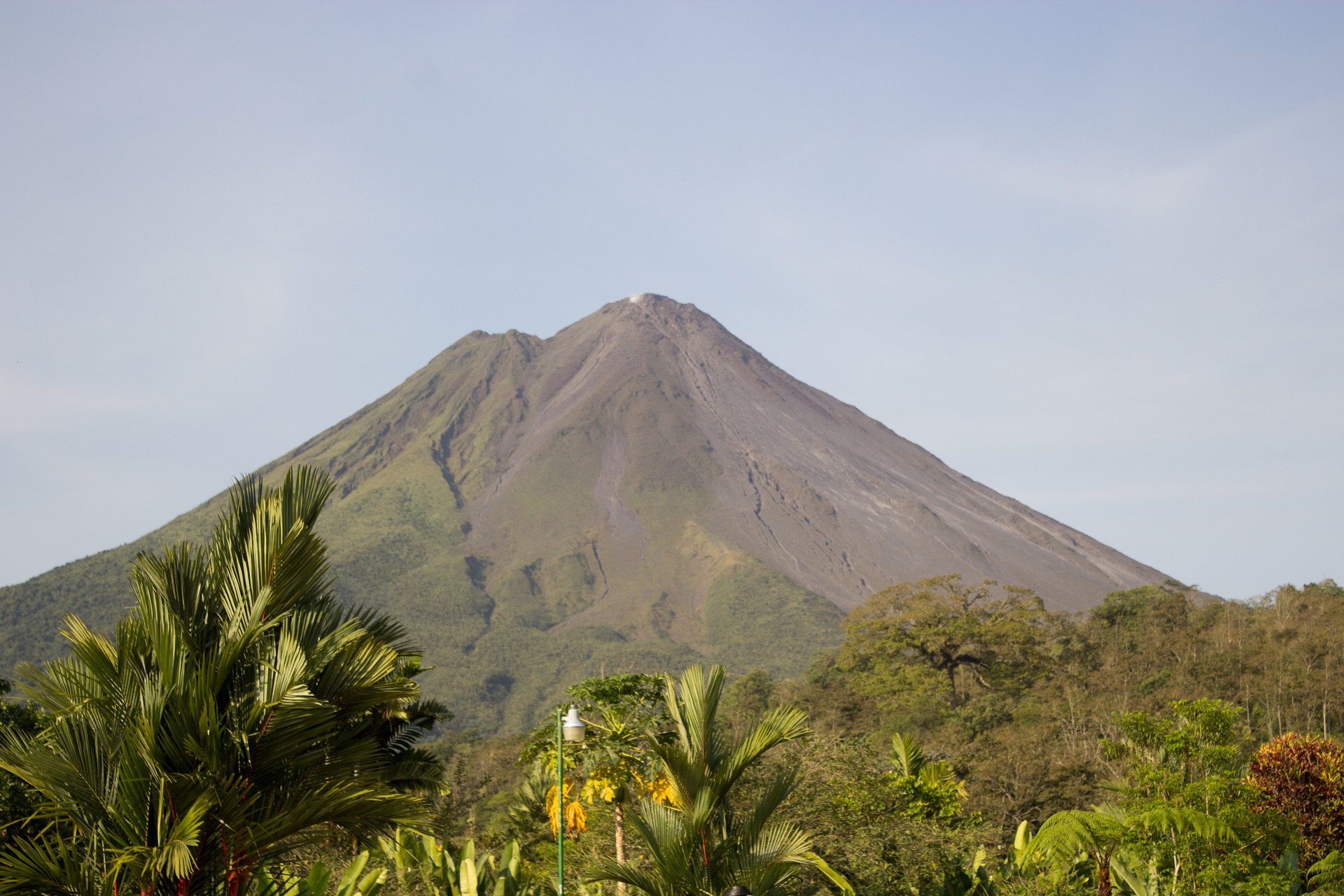
In the end, it was less complicated not having to cater to someone else’s schedule or needs; when we wanted to stop for a photo, we were able to and as it turned out, it was a much more relaxing and efficient way to get from Monteverde to Fortuna.
The driver, who looked like a young cattle farmer, pulled the 4WD truck into his family’s backyard in a small village near the lake and turned off the engine. It was the only house around and with the exception of an elderly man and an old frail woman who ended up jumping into the truck with us, we were the only people in sight for miles and it was starting to rain.
As the skies grew darker and I noticed that he was hooking us up to a very old, very dirty small motorboat with a 55 horsepower engine and no roof or tarp, I started getting nervous. We began to hear thunder and knowing that the journey across the lake was over an hour, and the boy did not speak a word of English or appear to understand our growing anxiety, the lightening was a growing concern.
We backed the boat into the lake and the four of us jumped aboard for a one hour fast boat ride across the lake to a somewhat bare shoreline, with a small dock and two people waiting to return to the other side. While nothing close to what we imagined, the rain held off and we managed to get across the lake safely and with dry clothes and bags. We were greeted by a one toothed rough looking character who was our taxi driver from the lake into the town of Fortuna.
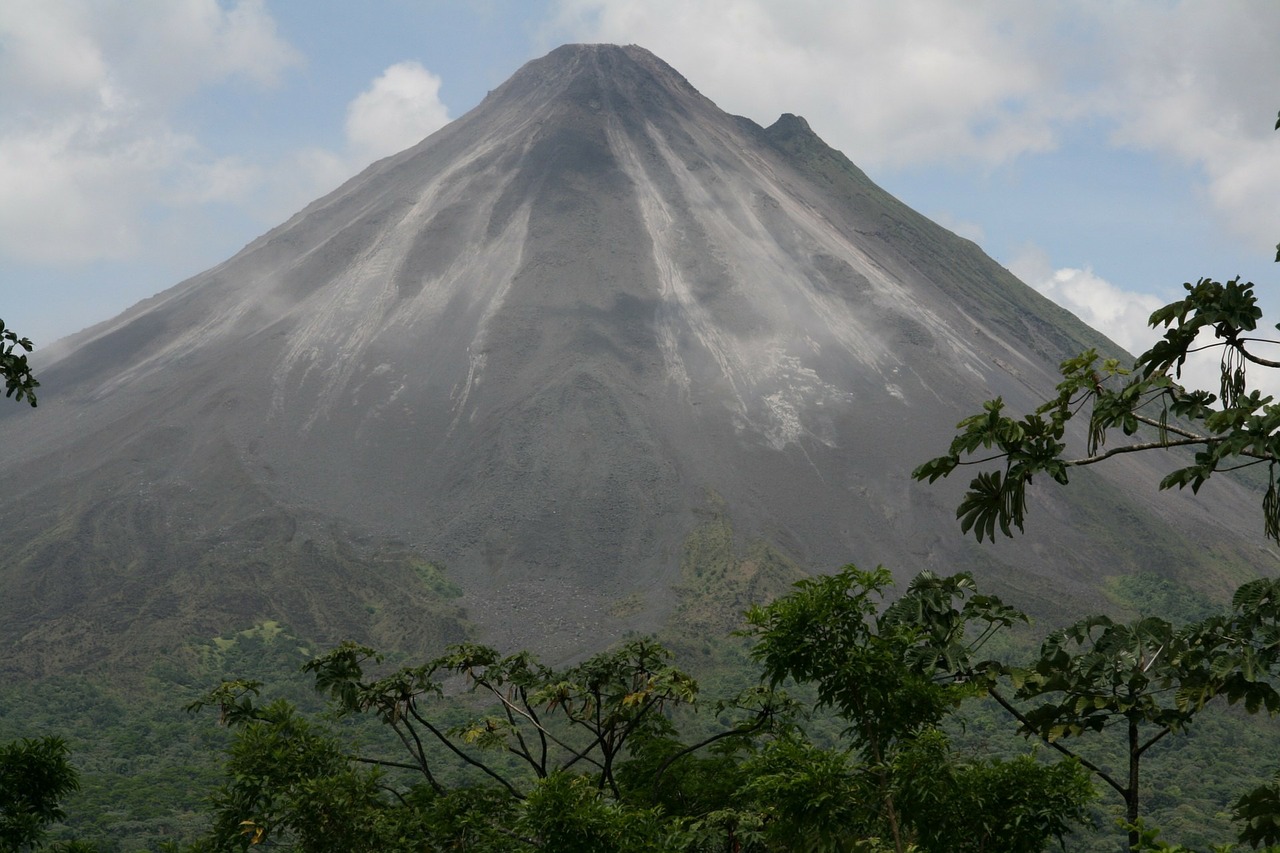
The roads were suddenly well paved and the gardens on the sides of the roads were well groomed, green and bountiful. It felt as if we had just crossed the border from Mexico to southern California. We passed the Tabacon Resort, well known for its natural Hot Springs. While Volcano Arenal was supposedly in front of us, we managed to only see a quarter of it since the clouds were creeping further and further down the mountain.
We headed towards the recommended Hotel San Bosco for $30 a night including tax after a short period bargaining. It was an upstairs room that included air conditioning with a double bed, one single bed and hot water. We found that many of the rooms catered to families and they were priced accordingly. The place was apparently known for its balcony views of the volcano however apparently Fortuna only views the volcano from one angle and this was not the angle where you could see the lava and rocks spewing from the top after dark.
The sky began to darken quickly as we approached Fortuna for the first time. No more than five minutes before we closed the door to our room, the heavy rains began. It was probably the hardest, most intense rainfall we had experienced since our arrival.
We spent the next two hours doing laundry by hand until the rain finally softened to a light to medium trickle; enough to venture into the town to grab a bite to eat before crashing for the night. We discovered Restaurant Nene, apparently a local recommended hang-out on a side road off the main drag. Mostly Costa Rican ‘typia’ food, it had no atmosphere and was fairly noisy and sparse.
Fortuna Earthquake
At around 4 am the next morning, I felt the room shake. The bed was moving and the sink in the bathroom was clanking loudly. I immediately grabbed for Jarod before either one of us were conscious enough to realize that we had either just experienced an earthquake or extreme activity from the volcano.
The rain had stopped but the night was extremely dark; once the movement stopped, we scrambled upstairs to the balcony to see if we could see any volcanic activity or people roaming the streets. With the exception of a couple wandering around the garden, the streets were bare.
A few hours later, we learned that it was in an earthquake, which apparently had originated in the Nicoya area – a region south of Fortuna where we were heading to shortly. 5.5 on the Richter scale, it was Jarod’s first earthquake and my second, although my first was about as intense as this one – a shaking room, noise from the furniture moving around and then seconds later, silence.
The next day, we took a taxi from a one legged driver who had been waiting for a trip in the square since early morning, which by Costa Rican standards is 4 am, not 6 or 7 am. He dropped us off at the base of a set of cabanas with a few swimming pools. A two to three hour hike from the base brought you to the bottom of the first of two lakes. We managed to hitch a ride in a 4WD from three Costa Ricans – all of them in the travel business.
Two women ran a travel agency in San Jose and were investigating the area to update their own information for their clients and one man, who was in the travel business and lived in Fortuna. The younger girl was in her early twenties, and had spent three months studying English as a foreign language in Boston a few years ago, so we were able to communicate with them fairly and had some common references to share in the car.
We stopped at the observation point for a view of the lake before, then headed around the lake until we reached the bottom. There were about a dozen or so huts where people could pitch a tent, a couple of picnic tables and a restroom. There was only one other vehicle and no people around. We jumped out at this point and decided to hike to the base of the volcano where you could view hot lava and hard lava rocks erupting from the volcano.
Volcan Arenal By Day
The hike was like many of the other hikes in Costa Rica – steep, muddy, dense, rainy and full of tropical wildlife sounds. It started to rain on our way up the hill, so it was difficult to move quickly since the roads were slippery and the mud was deep. It was not clear which path we should take and there were no cars or people at the base nor was there any kind of official national park office or map.
According to the books we read on the area, rangers would tell us where to go and how far was safe to hike. With no guidance as the book suggested, and not much time before dark, we hiked the two kilometers up the steep rocky path as quickly as we could in the pouring rain. This route gets you as close to the volcano as you can safely go without climbing to the crater rim itself, which apparently is extremely dangerous. A few have attempted it and for the most part, died before they made it to the top. It also puts people on a local rescue team at risk so is highly not recommended.
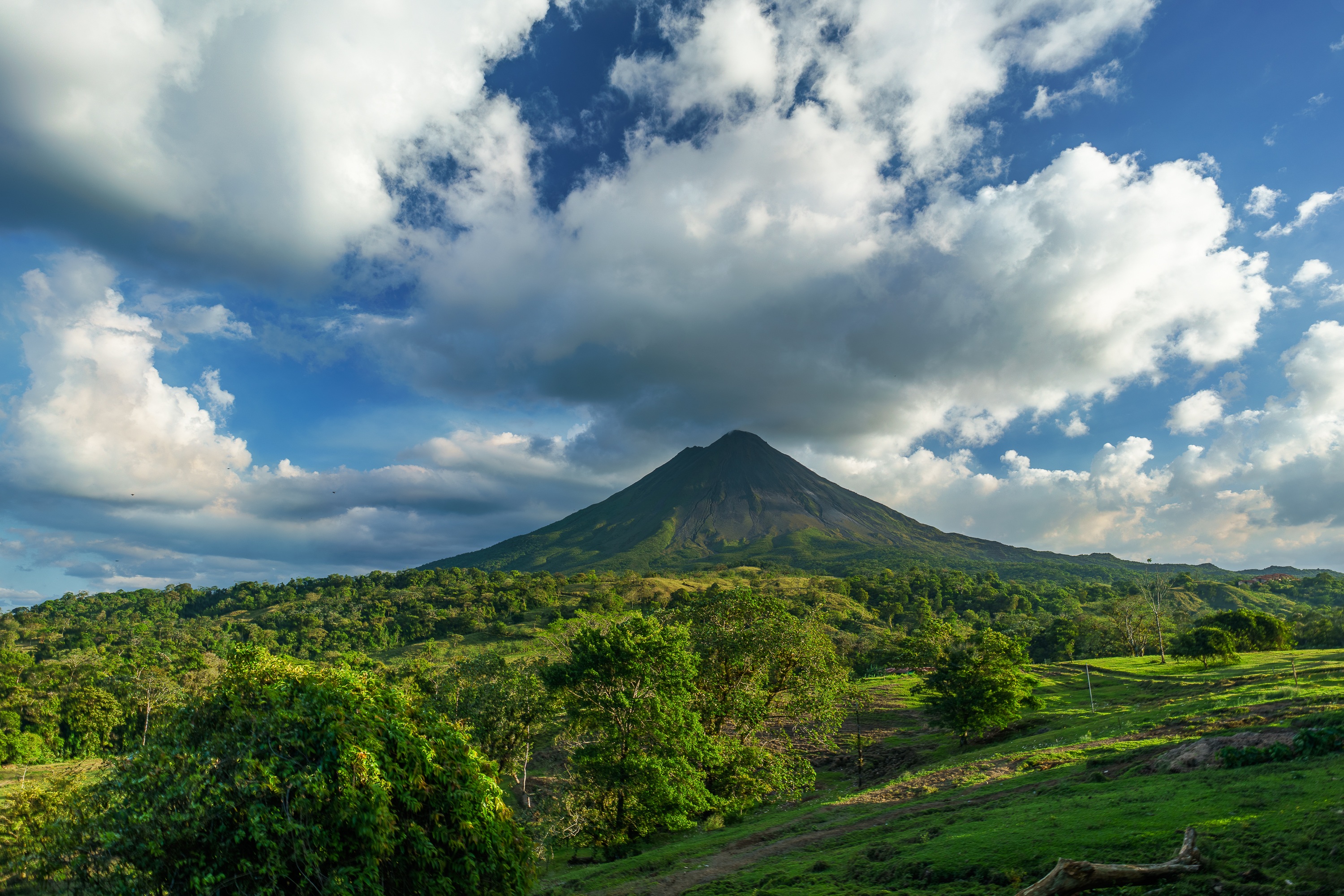
In the U.S. and likely the rest of the first world, regulations would prohibit anyone climbing anywhere near an active volcano; the major difference in experience between Niagara Falls and Victoria Falls in Zimbabwe, where there is only one small guard rail. The rest is vast open space between you, the slippery ground beneath you and the glorious falls in front of you.
When we reached the top, albeit a little disconcerted from the rain and darkness, we felt a broadening invigorating ‘head rush,’ the feeling one gets when they reach a significant summit.
There was an “intensity” from this majestic, roaring volcano immediately in front of us. The air was different and the clouds were thick and sinking around us. We were amidst large hard lava rocks, which had been spewed from the top. We could also see the hot glowing lava sliding down the side of the volcano; apparently this happens almost daily at Volcan Arenal.
By the time we made it down to the bottom of the mountain and into the park grounds, the rain had slowed down, but there were still no people to be found. We had hoped to catch a lift to the top before the heavy afternoon rains began.
Both exhausted at this point and not in an hurry to hike the eight kilometers back to the top or the two-hour hike in the other direction, we sat and rested at a stone table for twenty minutes or so. Jarod then spotted a man in a nearby beaten up blue station wagon and ran over to see if the man spoke English and if he would be heading out of the park anytime soon. Apparently he was waiting for two women who were hiking around the lake….daughters of good friends so he said.
American Ray, who had been living in Costa Rica for nearly a dozen years, offered us a lift to the top of the lake. On the way, we found his friends along the side of the road and picked them up only to learn that they were heading to the same place we were – The Tabacon Resort and Spa. After having spent several days doing adventurous excursions, tough hikes and trekking through muddy wet rainforests, we were ready for an intense afternoon of luxury.
Volcan Arenal by Night and Tabacon Resort, Spa & Hot Springs
While costly in comparison to other typical excursions, we ended up buying an entire package for $50+ each. This included a wondrous selection of thirty one hot springs, pools and rivers, a large hot swimming pool with a slide and stools in front of a bar serving exotic drinks, hot tubs, a sauna, a massage, mud pack and dinner. I told the Maitre D that we were on our honeymoon and as Jarod and I exchanged winks, so did the Maitre D; our goal was obviously to get the best seat in the house after spending hours in the hot springs, to view the erupting volcano by night. He made a note as we left for our hot spring experience and told us in broken English that ‘he would see what he could do.’
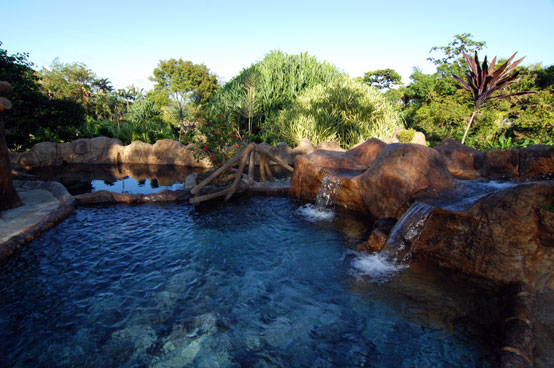
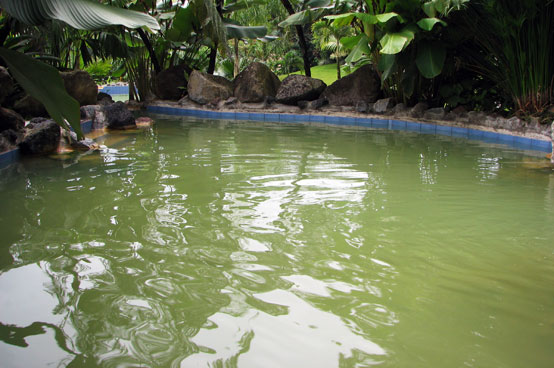
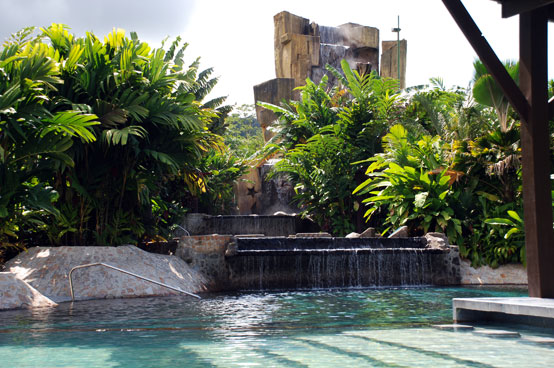
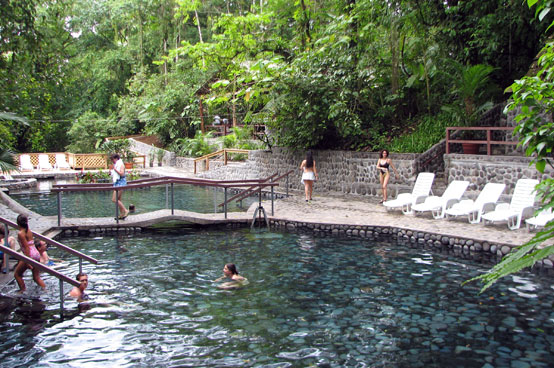 Above photo credits: Arenal.net
Above photo credits: Arenal.net
After a muddy, wet and steep hike, three hitched lifts and a 4 am earthquake, our bodies were ready to soak. We started with a frozen daiquiri at the ‘swim up’ bar, before we hit the water slide.
Like two twelve year old children, we did handstands, a few swing outs in the pool and then put on a west coast dance performance on the side of the pool to the beat of 1980s Reggae music. This was followed by one soak after another in the numerous hot springs, all of which were nestled between a series of colorful vivacious flowering gardens.
A few quaint bridges crossed the flowing natural streams, which led to small and medium sized pools, where people found their own private space to relax. There were enough pools to find one of your own if you chose; more often than not, completely surrounded by bright tropical flowers in bright purples, pinks and yellows.
By the time our fingers were pruned, our pores were tight and we felt like drowned rats, we went for an hour long massage and face mudpack. The latter was a natural mudpack that they pasted to your face and neck with a brush. After twenty minutes of drying time, you re-entered the hot springs for a cleanse. By this time, not only had the rain resurfaced, but so did heavy thunder and lightening.
The lightening was close; however, this did not deter at least a hundred people from staying pool bound, children included. To my surprise, people continued to sit under the powerfully strong hot waterfalls over the main streaming river as the lightening intensified.
We changed and headed to the restaurant, to discover that our Maitre D friend had arranged the best table in the house for us. Although somewhat misty and cloudy, we were able to get an excellent view of the erupting volcano by night. Through the binoculars, you could clearly see the burning hot lava and tumbling rocks spilling from the crater down the side of the crater. It was a splendid sight and one of the more memorable experiences we shared on the trip.
We took a 6 am bus out of Fortuna heading south to San Ramon, where we would make a connection to harboring town Punteranas, on the west side of the peninsula. We met up with four other Gringoes on the way; two Germans and two Dutch guys; one of whom was robbed at the San Ramon bus station, the same bus station where we lounged for two hours waiting for our connection. The two Dutch guys were forced to remain behind in order to head over to the police station and report the incident. The upside was that the police took action immediately and told them that they would have police check at every stop, suggesting that the person who stole his wallet was probably on one of the buses. More promising than the outcome of Joanne and I’s theft experience on the east side of Kenya several years ago.
I spent an hour walking around in the rain, in search of a phone that actually worked, some local ‘typia’ snacks, a good strong Costa Rican coffee with hot milk, and anything new and interesting I had not discovered yet. My Spanish vocabulary was very limited so I re-discovered all of the interesting ways of communicating using sign language and gestures. In all situations, it seemed to work and I found myself wanting to hang around the little village a little longer just to explore the little shops and people watch. While not a terribly interesting or unusual little village, I found the people extremely friendly, curious, honest and forthcoming. Both sides have so much to learn.
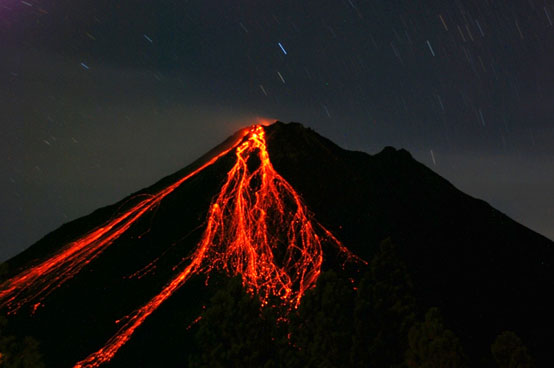 By night – credit: Arenal.net
By night – credit: Arenal.net

Renee Blodgett is the founder of We Blog the World. The site combines the magic of an online culture and travel magazine with a global blog network and has contributors from every continent in the world. Having lived in 10 countries and explored over 90, she is an avid traveler, and a lover, observer and participant in cultural diversity. She is also the founder of the Magdalene Collection, a jewelry line dedicated to women’s unsung voices and stories, and the award-winning author of the bestselling book Magdalene’s Journey
She is founder of Blue Soul Media and co-founder of Blue Soul Earth as well as the producer and host of the award-winning Blue Soul CHATS podcast, that bridges science, technology and spirituality. Renee also founded Magic Sauce Media, a new media services consultancy focused on viral marketing, social media, branding, events and PR. For over 20 years, she has helped companies from 12 countries get traction in the market. Known for her global and organic approach to product and corporate launches, Renee practices what she pitches and as an active user of social media, she helps clients navigate digital waters from around the world. Renee has been blogging for over 16 years and regularly writes on her personal blog Down the Avenue, Huffington Post, BlogHer, We Blog the World and other sites. She was ranked #12 Social Media Influencer by Forbes Magazine and is listed as a new media influencer and game changer on various sites and books on the new media revolution. In 2013, she was listed as the 6th most influential woman in social media by Forbes Magazine on a Top 20 List.
Her passion for art, storytelling and photography led to the launch of Magic Sauce Photography, which is a visual extension of her writing, the result of which has led to producing six photo books: Galapagos Islands, London, South Africa, Rome, Urbanization and Ecuador.
Renee is also the co-founder of Traveling Geeks, an initiative that brings entrepreneurs, thought leaders, bloggers, creators, curators and influencers to other countries to share and learn from peers, governments, corporations, and the general public in order to educate, share, evaluate, and promote innovative technologies.








